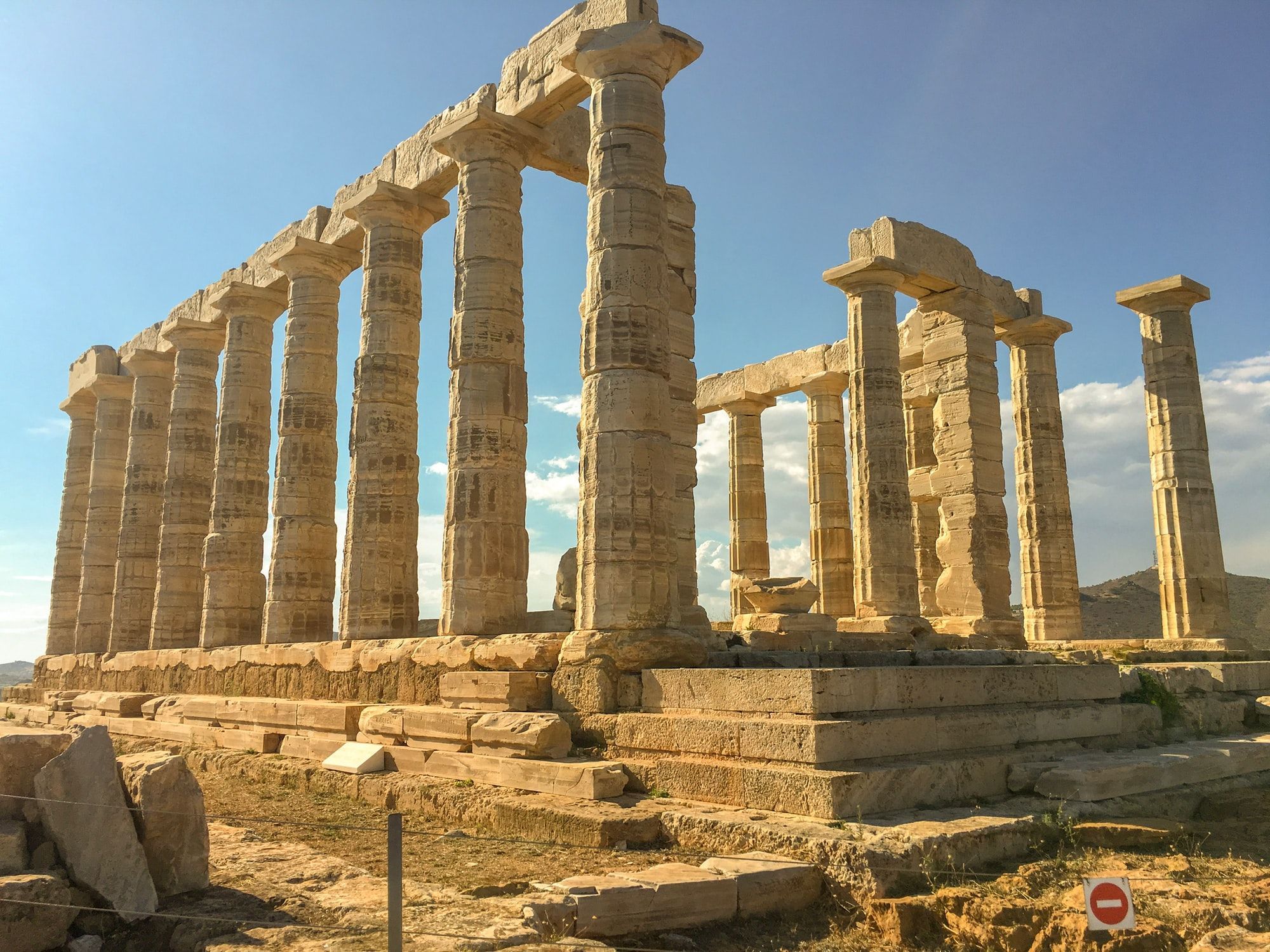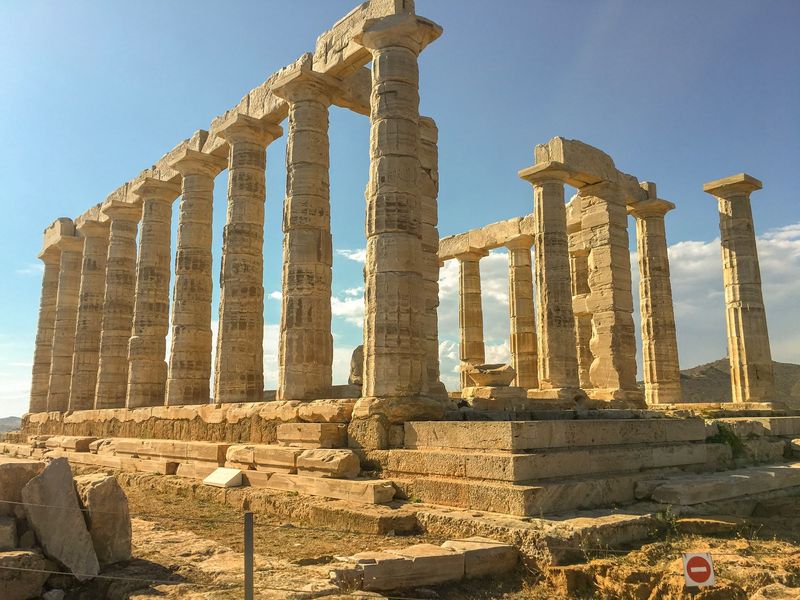
This article relates to episode 3 in the series ‘Cyber Security in the Ancient World’. Since there will be two videos on Herodotus - this being the second one - this will focus on the four examples of secret communication that Herodotus discussed. The article Cyber security in the Ancient World — Part 2 provides background information on Herodotus’ life and work.
The earliest Greco-Roman source which provides us with unambiguous examples of secret communication is not Homer’s Iliad but Herodotus’ Histories. We can find at least 61 instances of trickery and deceit in Herodotus’ work.[1] To be more precise: all but three instances of written communication in Herodotus’ work – fourteen letters (Histories, 1.123; 1.125; 1.187; 3.40; 3.42; 3.122; 3.128 (2x); 5.14; 5.35; 6.4; 7.239; 8.22; 8.128) and two other written messages (5.28 (a message written on a slave’s head); and 8.22 (an inscription)) – are related to trickery and deceit, and four of these sixteen instances of communication are clear examples of secret communication or hidden confidential messaging: that is, steganography (1.123; 5.28; 7.239; 8.128).[2]
The first instance of secret communication that Herodotus offers is an account of steganography that occurs in Book 1.[3] According to Herodotus, political intrigue and feuding among the Persians once prompted the Median general Harpagus, to plot against his king Astyages, seeking revenge for the murder of Harpagus’ son by the king. Harpagus, therefore, plotted to assist the Persian prince Cyrus against Astyages in a coup d’état. Having garnered support from some Median nobles, Harpagus sent word to Cyrus through a message hidden in the body of a hare, since he desired to make his intent known to Cyrus. Yet, the plot obviously had to remain a secret, and, as Herodotus told us, all roads were guarded. Harpagus, therefore, decided to hide a message in a hare that was then presented to Cyrus as a gift (Histories, 1.123-1.124).[4] After receiving the gift, cutting the hare open and reading the message, Cyrus acted upon Harpagus’ advice to rally the Persians against the Medes, and with the help of Harpagus, Cyrus was victorious (1.127). Herodotus finished his story by stating that in this way king Astyages was deposed from his sovereignty after ruling cruelly for 35 years (1.130) The example clearly shows that Herodotus had negative views towards oriental despotic regimes and that he believed that there was a close connection between these regimes and the use of secret communication. The story of the steganographic message in the hare is a direct reference to overcoming tyrannical rule since Harpagus urged Cyrus to revolt against Astyages. As will be shown in the other three examples of steganography found in Herodotus work, this relationship between oriental despotic regimes and the use of secret communication keeps repeating itself, culminating in our last example: Demaratus’ letter to the Spartans (Histories, 7.239). As will be discussed later in this chapter, the example of Demaratus shows how a Spartan in an oriental context first used secret communication (at least, in the history told according to Herodotus).
The second Herodotean story in which steganography played a crucial role can be found in book 5 of the Histories.[5]According to Herodotus, Aristagoras, ruler of Miletus, once launched a joint expedition with the Persian satrap Artaphernes to conquer Naxos, to bolster his political position (5.28-32). The mission was a debacle and Herodotus reports that, sensing his imminent removal as a sole ruler, Aristagoras chose to invite the whole of Ionia into rebellion against the Persian king Darius the Great (5.33-35.1). According to Herodotus, to foment this revolt (the Ionian Revolt), [6] Histiaeus the sole ruler of Miletus shaved the head of his most trusted slave and tattooed a secret message on it urging his son-in-law Aristagoras who was residing in the Persian city of Susa to revolt against king Darius. As in the previous example, secret communication was the only safe way of sending the message since again a revolt was discussed that had to be kept secret and all roads were guarded as Herodotus tells us (5.35.3). Histiaeus then waited for the slave’s hair to grow back, and subsequently sent the man to Aristagoras in Miletus, instructing him to let Aristagoras shave his head again for the message to become visible (5.35.2-4).[7] In Herodotus’ story of Histiaeus’ message, we see a rebellion in an oriental state being discussed in secret by officials of the highest ranks. There are similarities with the previous example of Harpagus’ message to Cyrus hidden in a hare. Again, the purpose of the rebellion is to depose of a non-Greek ruler (the Persian king Darius). Yet, in the previous example the instigator of the rebellion came from an oriental state (Harpagus from Media), while in this case the instigator was Histiaeus, the Greek ruler of Miletus in Asia Minor who was communicating with his son-in-law Aristagoras in Persia. Ceccarelli presumes that, according to Herodotus, Histiaeus tattooed the word ‘revolt’ in plaintext on the slave’s head.[8]When the message would have been written in ciphertext it would have been even harder to crack if the message was discovered an enemy. However, in his account Herodotus did not disclose what Histiaeus’ message said. Whatever the exact wording of the message was, the information was enough to prompt Aristagoras to convene a council and prepare for rebellion against Persia according to Herodotus (5.36; see also Aeneas Tacticus, How to Survive Under Siege, 31.28-29; Aulus Gellius, Attic Nights, 17.9.18-27; Polyaenus, Stratagems of War, 1.24). Moreover, sending the slave was a clever idea from Histiaeus’ point of view. Slaves had little to lose, were used to obscurity, and were believed to live lives of duplicity. Therefore, the seemed useful as spies as Richmond argues.[9] According to Ceccarelli, the story of Histiaeus’ message fits in well with Herodotus’ negative view towards autocratic rulers in the Near East, since the example shows how in the Near East slaves could be mutilated to send messages.[10]However, tattooing slaves was not uncommon in the ancient Greek world either. Marking your slaves was a way to punish them and to show that they were your property. As Kamen argues, while not every slave was marked:
During the periods of Greco-Roman antiquity when the institution of slavery was most highly developed – namely, Classical and Hellenistic Greece, and late Republican and Imperial Rome – the topos of the ‘marked slave’ proliferated in all genres of literature.[11]
To give a few examples, in Aristophanes’ The Wasps (844-850; 1372-1375), and Women at the Thesmophoria (773-784) we read about slaves whose bodies were punctured, punctuated, and tattooed. As duBois argues, her pubis was covered with black pitch used to prepare writing tablets.[12] So, one could literally write on a body, the body hereby being seen as a worthless object.[13] Tattooing involves pricking the flesh with iron needles and then pouring ink into the wounds.[14] As Petronius says, this is so that the wounds prepared by the iron absorb letters – making tattooed messages permanent (Satyricon, 106). If text was written on a slave’s back or his head (as in Herodotus’ story) the bearer could not even see it himself. In this way the slave was forever marked by his master, showing his master’s power over him, even if a slave was later freed.[15] Another practical point that must be made here is the usefulness of the method. Shaving the slave’s head, tattooing a message on it, and waiting for the hair to grow back, would have been a very time-consuming method. Therefore, it must have been useless when a message had to be transmitted as quickly as possible. This may imply that Histiaeus’ message to Aristagoras was not very urgent.
We cannot know with any certainty how much of the story is true, and how much is made up by Herodotus. Yet, it must be pointed out that the Ionian Revolt formed the start of the Greco-Persian war – and the first time the Greek city states came together on a large scale to form an alliance against the Persian invaders. Herodotus’ story of Histiaeus, Aristagoras and the slave, therefore, shows that according to Herodotus secret messages may have played a role in important revolts against the Persian invaders and for a free Greece – something we will see in further detail later in this chapter.
The third instance of a secret letter occurs in Book 8 of Herodotus’ work. This story is set at the siege of Potidaea in 479 BCE,[16]after the battle of Salamis. Timoxenus, strategosof the Scionians, betrayed his city by trading messages with the Persian commander Artabazus through letters hidden under the feathers on arrows that were shot into an agreed place(8.128.1). The messages were wrapped around the shaft of the arrow that was subsequently covered in feathers to make the message invisible, just as the message on the slave’s head was covered by his hair (5.35.2-4; see also Aeneas Tacticus, How to Survive Under Siege, 31.25-27).[17]Timoxenus’ treachery was apparently discovered only when Artabazus missed his aim. Instead of his steganographic arrow falling in the spot agreed upon, Artabazus accidentally shot a Potidaean. People who came to aid the wounded man found the letter on the arrow and Timoxenus’ betrayal became known (8.128-129.1).[18]This is a good example of Herodotus’ negative view towards non-Greek practices, since here a Greek (Timoxenus) betrayed his fellow Greeks by aiding the Persians in using secret communication. Unlike truthful Greeks, Herodotus seems to imply in the passage, Timoxenus acted like a traitor.
The final secret letter can befound in Book 7 of the Histories. It shows that according to Herodotus, the Spartans in the 5thcentury BCE already used secret communication as oriental states did. According to Herodotus, when the Spartan king Demaratus was in exile at Xerxes’ court in Persia, he wanted to send word to the Spartans to inform them about Xerxes’ invasion of Greece (480 BCE). Since Demaratus was afraid that the message would fall into the wrong hands, he wrote the message under the wax of a wax tablet. The seemingly blank tablet reached Sparta, and the Spartans were initially confused about what to do with an ostensibly blank tablet until Gorgo, the wife of King Leonidas, suggested that they look for a hidden message (7.239).[19] Here we see Spartans communicating with each other secretly yet in a partially oriental context, since Demaratus sent the message while he was in exile at the court of Xerxes of Persia. This implies that the Spartans probably learned to use secret communication from the Persians, e.g., when living amongst them, at least according to Herodotus.
Herodotus does not tell us why it was Gorgo who discovered the message or how she discovered it,[21] but according to Herodotus, because of Demaratus’ letter, the Spartans were warned in time, informed the other Greeks, and together they defeated the Persians at the Battle of Salamis (7.239; 8). This is significant since Demaratus had to rely on the ingenuity of the Spartans to discover the secret message.
The apparent success of the message being delivered and understood seems to be the major point of discussion for modern historians of cryptography. Sheldon, for example, sees Demaratus’ message as ‘one of the most important messages in all of Greek history’.[22]And according to Singh, Xerxes had lost the vital element of surprise and, when the Persian fleet approached the Bay of Salamis near Athens, the Greeks were prepared.[23] This shows how modern historians of cryptography often tend to present Herodotus’ stories as clear historical facts, attributing the direct influence of the secret messages that Herodotus discusses to the success of subsequent historical events.
The case, I argue, is more complex. The four instances of steganography in Herodotus’ work are unique since they have three features in common that cannot be found in this combination elsewhere in the work in connection with other messages or in other instances of trickery and deceit.[24]First, all four instances are examples of long-distance communication sent when roads were guarded. The steganographic methods used for sending the messages were purposefully chosen instead of cryptographic methods and designed to raise as little suspicion as possible among third parties. Secondly, there is no intra-Greek exchange of messages. Messages were either sent between a Greek and a non-Greek (Timoxenus and Artabazus), between non-Greeks (Harpagus and Cyrus; Histiaeus and Aristagoras), or in a non-Greek setting (Demaratus as exile in Persia). Thirdly, all four instances deal with an aversion to oriental despotism. In the case of Timoxenus and Artabazus, Herodotus showed this aversion by overtly disapproving of Timoxenus’ betrayal, while the other three cases even deal with overthrowing an oriental despot (Harpagus and Cyrus; Histiaeus and Aristagoras; Demaratus to the Spartans). We can see a pattern in the secret messages that occur in Herodotus’ ‘history’. As Fabule points out:
the pattern reflects the following scenario: under the thumb of some potentate, a leader (foreign tyrant, a general, or client-king) sends a cunningly disguised secret message, that related information detrimental to his overlord.[25]
Written messages appear to have been more common in the Near East than in Greece in Herodotus’ days.[26]In fact, until the first reading culture appears in Athens in the 4thcentury BCE (and perhaps even after that) in ancient Greece letters and long distance communications were often related to the Near East and their tyrannical regimes and believed to be fraught with dangers.[27]Homer’s story of Bellerophon’s tablet (see vido 1), potentially appeals to this oriental context of letters and letter writing in terms of the readiness of ancient scholia critics to interpret Proetus’ writing as a kind of Egyptian hieroglyphic text (Homer, Iliad, 6.166-170; 178).[28] Rosenmeyer further points out that the letter sent in Bellerophon’s story encapsulates two major themes related to letter writing that can often be found in Greek literature: a deceitful letter and an association between letters and deceitful women – hereby again signposting towards the decidedly negative view towards letter writing in the archaic period.[29] By the end of the 5th century BCE literacy was most likely more widespread in the Greek world than before this date and the exchange of letters took place regularly, it seems – based on the large number of inscriptions that have survived from this period.[30]
Yet, in Herodotus’ Histories letters are still relatively exceptional: only fourteen instances are found – none of which concern direct intra-Greek communication in a Greek context (as Demaratus’ letter to the Spartans was an indirect communication set in an oriental context).[31] And secret letters were even more exceptional with only four examples in Herodotus' whole book. However, secret messages are - by their very nature 'secret'. So, maybe Herdototus knew other examples too, but decided not to discuss them so clearly in this text. By analyzing the Histories in detail, we may find other references to secret communication too.
[1]Herodotus, Histories, 1.21.1-22.3; 1.59.3-6; 1.60.3-5; 1.80.2; 1.96.2-98.2; 1.123; 1.125; 1.187; 1.191; 1.207.6-7; 2.100.2-4; 2.121A.1; 2.121D; 2.121E; 2.133; 2.162.1; 2.172; 3.1.3-5; 3.4; 3.16.6; 3.61; 3.69.3-6; 3.85-86.2; 3.122; 3.123.2; 3.128 (2x); 3.130.1-2; 3.153-158.2; 4.134.3; 4.139.2; 4.146.4; 4.154.3-4; 4.201; 5.12-13; 5.20; 5.24-25.1; 5.35; 5.49-50; 5.63.1; 6.4; 7.239; 8.5; 8.22; 8.24-25.2; 8.27.3; 8.28; 8.75-76; 8.87; 8.109; 8.128-129.1; 8.137; 9.33.4-5; 9.34; 9.94; 9.98.2-4; 9.110.2-112; 9.116.2-3; 9.120.2-4.
[2] The three letters that did not involve trickery and deceit are two letters sent between Amasis and Polycrates (Herodotus, Histories, 3.40-42), and a letter from Darius to Megabyzus instructing the latter to attack Paeonia (Herodotus, Histories, 5.14.1).
[3] Although modern historians of cryptography often present the stories as clear facts (e.g., on Demaratus’ letter to the Spartans see Bauer 2013, 7-8; Bartlett 2002, 8-12; Singh 1999, 5), it cannot be said with certainty how much of the stories is fact and how much is fiction. See for this designation of the Spartans being depicted as having ‘non-Greek’ practices e.g., Cartledge 2009; 2013; Osborne 2011.
[4] On Harpagus’ motives for sending the message and his role in the story as described by Herodotus, see Gray 1995, 185-211, see also: Polyaenus, Stratagems of War, 3.13.3.
[5] Modern cryptographers again, often present this story as an historical account based in fact (Bauer 2013, 8; Singh 1999, 6).
[6] On causes of the Ionian Revolt as discussed in Herodotus’ work, see Evans 1976; Forrest 1979, 315-317; 320-322; Manville 1977, 80-91; Waters 1985. See also Blamire 1959; Lang 1968.
[7] Chapman incorrectly suggests that Herodotus’ work is the only account of the Ionian Revolt available to us (Chapman 1972, 546). In addition to Herodotus’ work, we have e.g., Aeschylus’ The Persians, and Thucydides’ History of the Peloponnesian War, 1.22. On Histiaeus’ role in Herodotus account of the Ionian Revolt see Blamire 1959; Chapman 1972, 546-568; Evans 1976; Lang 1968.
[8]Ceccarelli 2013, 114.
[9]Richmond 1998, 6.
[10]Ceccarelli 2013, 127.
[11]Kamen 2010, 95 + note 1. On other purposes of tattooing, including decorative tattooing see e.g., Fisher 1993; Kamen 2010; Jones 1987; 2000.
[12] DuBois 1988-I, 75. See also: DuBois 1988-II; 1991; 2003; 2007; Kamen 2010.
[13] DuBois 2003, 4; Jones 1987; 2000.
[14] Kamen 2010, 98.
[15] DuBois 1988-I, 75-78; 2007; Kamen 2010, 95-98
[16] For the date, see e.g., Burliga 2008, 92-93. See also Thucydides, History of the Peloponnesian War.
[17] Godley 1925, 131; How & Wells 1928, 700.
[18] This example shows that secret communication always runs the risk of discovery.
[19] See also Aulus Gellius, Attic Nights, 17.9.16-17; Polyaenus, Stratagems of War, 2.20; Justin, Epitome of the Philippic History of Pompeius Trogus, 2.10.12-17; Julius Africanus, Kestoi, 53. According to Justin it was not the king’s wife, but his sister who discovered Demaratus’ message (Justin, Epitome of the Philippic History of Pompeius Trogus, 2.10.12-172.10.13). See for a similar example of a secret message written under the wax of a wax tablet by Hamilcar the Rhodian in the time of Alexander the Great: Aulus Gellius, Attic Nights, 17.9.16-17; Justin, Epitome of the Philippic History of Pompeius Trogus, 21.6. As Millender points out, Herodotus’ account of the Spartans’ reception of this message credits the Lacedaemonian authorities with the ability to read and implies Gorgo’s familiarity with wooden writing tablets (Millender 2001, 142). See also Dvornik 1974, 57; Sheldon 1987, 28; Sheldon 2005, 42.
[20] Kelly 1985, 143.
[21] The passage in which Gorgo discovered Demaratus’ secret message is the oldest known passage in which a woman took the initiative in deciphering a secret message. Later – in Roman love elegy – we find many examples in which the woman took initiative in sending secret messages (see Propertius, Tibullus, Ovid; especially Ovid, Ars Amatoria).
[22] Sheldon 1986, 39.
[23] Singh 1999, 5.
[24] Ceccarelli 2013, 113. For a list of all instances of trickery in Herodotus’ Histories see Hollmann 2005, 316-323.
[25] Fabule 2011, 36. For a concise list of exiled or alienated Greeks who, for their own purposes, solicited Persian assistance against their fellow-citizen, see Boedeker 1987, 191-192. The word ‘tyrant’ has a negative meaning in our modern world. Yet, it must be pointed out that tyrannos in Greek can simply be translated as an absolute ruler, unlimited by law or constitution as opposed to the Greek democratic system where there was no absolute ruler. The rule of a tyrannos in the Near East was a bureaucratic autocracy and was marked by an institutional harshness and distance between ruler and ruled (Dewald 2003, 28-33; Ferrill 1978, 385-398).
[26] Ceccarelli 2013, 185. See for letters and letters writing in the ancient Near East e.g.: Bellamy 1989, 291-292; Luschan & Andrae 1943, 108-109; Mallowan 1966; Mylonas Shear 1998, 187-189.
[27] See e.g.: Apollodorus, Epitome, 3.7; 5.19; Hellanicus Fragment 178a, in: Fragmente der Griechischen Historiker 4; Pausanias, Descriptions of Greece, 10.31.2; Plato, Apology, 41b; Herodotus, Histories, e.g., 1.99-100. See also Ceccarelli 2013, 24.
[28]Bellamy 1989, 289; Ceccarelli 2013 60; Rosenmeyer 2001, 39.
[29]Rosenmeyer 2001, 42–44.
[30] Yet, absence of evidence is not evidence of absence. Therefore, we must be careful when making such claims about literacy in ancient Greece (Ceccarelli 2013, 185). However, despite multiple investigations there is still no agreement on the degree of literacy achieved by all the Greeks in the late archaic and classical periods. See e.g.: Boring 1979; Cartledge 1978; Clanchy 1979; Goody 1986; Goody & Watt 1968; Harris 1989; Havelock 1963; 1982; Harvey 1966; Immerwahr 1990; Steiner 1994, 4; Street 1984; Swiggers 1996; Thomas 1989; Turner 1952.
[31]Ceccarelli 2013, 113.
Bibliography:
Bartlett, J. (2002, March 17). The Ease of Steganography and Camouflage. SANS Institute InfoSec Reading Room.
Bauer, C. P. (2013). Secret History: The Story of Cryptology. Boca Raton/ London/ New York: CRC Press - An Imprint of Taylor and Francis Group.
Bellamy, R. (1989). Bellerophon’s Tablet. The Classical Journal, 84 (4), 289-307.
Blamire, A. (1959). Herodotus and Histiaeus. The Classical Quarterly, 9 (2), 142-154.
Boedeker, D. (1987). The Two Faces of Demaratus. Arethusa, 20 (1), 185-201.
Boring, T. A. (1979). Literacy in Ancient Sparta. Leiden: Brill.
Bowie, A. M. (2007). Histories: Book VIII. Cambridge/ New York: Cambridge University Press.
Briant, P. (2002). From Cyrus to Alexander: a History of the Persian Empire. Winona Lake (Indiana): Eisenbrauns.
Burliga, B. (2008). Aeneas Tacticus between History and Sophistry: the Emergence of the Military Handbook. In J. Pigon, The Children of Herodotus. Greek and Roman Historiography and Related Genres (pp. 92-101). Newcastle: Cambridge Scholars Publishing.
Cartledge, P. (1978). Literacy in the Spartan Oligarchy. Journal of Hellenistic Studies (98), 25-37.
Cartledge, P. (2009). Ancient Greek Political Thought in Practice. Cambridge: Cambridge University Press.
Ceccarelli, P. (2013). Ancient Letter Writing: A Cultural History (600 BC-150 BC). Oxford: Oxford University Press.
Chapman, G. A. (1972). Herodotus and Histiaeus' Role in the Ionian Revolt. Historia: Zeitschrift für Alte Geschichte, 21 (4), 546-568.
Clanchy, M. T. (1979). From Memory to Written Record: England, 1066-1307. Cambridge (Massachusetts): Cambridge University Press.
Dewald, C. (2003). Form and Content: The Question of Tyranny in Herodotus. In K. A. Morgan, Popular Tyranny: Sovereignty and Its Discontents in Ancient Greece (pp. 29-58). Austin: University of Texas Press.
DuBois, P. (1988-I). Inscription, the law and the comic body. Mètis: Anthropologie des mondes grecs anciens, 3 (1-2), 69-84.
DuBois, P. (1988-II). Sowing the Body: Psychoanalysis and Ancient Representations of Women. Chicago: University of Chicago Press.
DuBois, P. (1991). Torture and Truth. New York/London: Routledge.
DuBois, P. (2003). Slaves and Other Objects. Chicago: University of Chicago Press.
DuBois, P. (2007). The Coarsest Demand: Utopia and the Fear of Slaves. Actes du Groupe de Recherches sur l’Esclavage depuis l’Antiquité, 29, 435-444.
DuBois, P. (2010). Out of Athens: The New Ancient Greeks. Cambridge (Massachusetts): Harvard University Press.
Dvornik, F. (1974). Origins of Intelligence Services: The Ancient Near East, Persia, Greece, Rome, Byzantium, the Arab Muslim Empires, the Mongol Empire, China, Muscovy. New Brunswick/ New Jersey: Rutgers University Press.
Evans, J. A. (1976). Herodotus and the Ionian Revolt. Historia: Zeitschrift für Alte Geschichte, 25 (1), 31-37.
Fabule, D. K. (2011). Information-gathering and the Strategic Use of Culture in Herodotus. Stellenbosch: University of Stellenbosch.
Ferrill, A. (1978). Herodotus on Tyranny. Historia: Zeitschrift für Alte Geschichte, 27 (3), 385-398.
Fisher, N. R. E. (1993). Slavery in Classical Greece. London: Bristol Classical Press/Duckworth.
Forrest, W. G. (1979). Motivation in Herodotos: The Case of the Ionian Revolt. The International History Review, 1 (3), 311-322.
Godley, A. D. (1920). Herodotus: The Persian Wars (Vol. I: Books 1-2; Loeb Classical Library 117). Cambridge (Massachusetts): Harvard University Press.
Godley, A. D. (1922). Herodotus: The Persian Wars (Vol. III: Books 5-7; Loeb Classical Library 119). Cambridge (Massachusetts): Harvard University Press.
Godley, A. D. (1925). Herodotus: The Persian Wars (Vol. IV: Books 8-9; Loeb Classical Library 120). Cambridge (Massachusetts): Harvard University Press.
Goody, J. (1986). The Logic of Writing and the Organisation of Society. Cambrigde: Cambridge University Press.
Goody, J., & Watt, I. (1968). The Consequences of Literacy. In J. Goody, Literacy in Traditional Societies (pp. 27-86). Cambridge: Cambridge University Press.
Gould, J. P. (2012). Herodotus (1). In S. Hornblower, A. Spawforth, & E. Eidinow, The Oxford Classical Dictionary (pp. 674-676). Oxford: Oxford University Press.
Gray, V. (1995). Herodotus and the Rhetoric of Otherness. The American Journal of Philology, 116 (2), 185-211.
Harris, W. V. (1989). Ancient Literacy. Cambridge (Massachusetts): Harvard University Press.
Harvey, F. D. (1966). Literacy in the Athenian Democracy. Revue des Études Grecques (79), 585-635.
Havelock, E. (1963). Preface to Plato. Cambridge (Massachusetts): Harvard University Press.
Havelock, E. A. (1971). Prologue to Greek Literacy. Cincinnati: University of Cincinnati.
Havelock, E. A. (1982). The Literate Revolution in Greece and Its Cultural Consequences. Princeton: Princeton University Press.
Hollmann, A. (2005). The Manipulation of Signs in Herodotus' Histories. Transactions of the American Philological Association (1974-2014), 135 (2), 279-327.
How, W. W., & Wells, J. (1928). A Commentary On Herodotus (Vol. 1 (Book I-IV); 2 (Book V-IX)). Oxford: Oxford University Press.
Immerwahr, H. R. (1990). Attic Scripts, A Survey. New York/ Oxford: Oxford University Press.
Jones, C. P. (1987). Stigma: Tattooing and Branding in Graeco-Roman Antiquity. The Journal of Roman Studies (77), 139-155.
Jones, C. P. (2000). Stigma and Tattoo, in: J. Caplan, Written on the Body: The Tattoo in European and American History. Princeton: Princeton University Press, 1-16.
Kamen, D. (2010). A Corpus of Inscriptions: Representing Slave Marks in Antiquity. Memoirs of the American Academy in Rome (55), 95-110.
Kelly, T. (1985). The Spartan Scytale. In J. W. Eadie, & J. Ober, The Craft of the Ancient Historian: Essays in Honor of Chester G. Starr (pp. 141-169). Lanham: University Press of America.
Lang, M. (1968). Herodotus and the Ionian Revolt. Historia: Zeitschrift für Alte Geschichte, 17 (1), 24-36.
Lateiner, D. (1990). Deceptions and Delusions in Herodotus. Classical Antiquity, 9 (2), 230-246.
Luschan, F. v., & Andrae, W. (1943). Ausgrabungen in Sendschirli. v. 5. Die Kleinfunde von Senschirli. Mittheilungen aus den orientalischen Sammlungen 15. Berlin: De Gruyter.
Mallowan, M. E. (1966). Nimrud and Its Remains I. London: Collins.
Manville, P. B. (1977). Aristagoras and Histiaios: The Leadership Struggle in the Ionian Revolt. The Classical Quarterly, 27 (1), 80-91.
Millender, E. G. (2001). Spartan Literacy Revisited. Classical Antiquity, 20 (1), 121-164.
Mylonas Shear, I. (1998). Bellerophon Tablets from the Mycenaean World? A Tale of Seven Bronze Hinges. The Journal of Hellenic Studies, 118, 187–189.
Osborne, R. (2011). The History Written on the Classical Greek Body. Cambridge: Cambridge University Press.
Richmond, J. A. (1998). Spies in Ancient Greece. In: Greece and Rome (45-1), 1,18.
Rosenmeyer, P. A. (2001). Ancient Epistolary Fictions: The letter in Greek Literature. Cambridge/ New York: Cambridge University Press.
Sheldon, R. M. (1986). Tradecraft in Ancient Greece. Studies in Intelligence, 20 (1), 39–47.
Sheldon, R. M. (1987). Tinker, Tailor, Caesar, Spy: Espionage in Ancient Rome . Ann Arbor: UMI Dissertation Information Service.
Sheldon, R. M. (2005). Intelligence Activities in Ancient Rome: Trust in the Gods, but Verify. London/ New York: Routledge.
Sheldon, R. M. (2008). Espionage in the Ancient World: An Annotated Bibliography of Books and Articles in Western Languages. Jefferson/ London: McFarland and Company Incorporated Publishers.
Singh, S. (1999). The Code Book: The Science of Secrecy from Ancient Egypt to Quantum Cryptography. London: Fourth Estate.
Steiner, D. T. (1994). The Tyrant’s Writ: Myths and Images of Writing in Ancient Greece. Princeton: Princeton University Press.
Street, B. V. (1984). Literacy in Theory and Practice. Cambridge: Cambridge University Press.
Swiggers, P. (1996). Transmission of the Phoenician Script to the West. In P. Daniels, & W. Bright, The World's Writing Systems (pp. 261–270). Oxford: Oxford University Press.
Thomas, R. (1989). Oral Traditon and Written Record in Classical Athens. Cambridge: Cambridge University Press.
Turner, E. G. (1952). Athenian Books in the Fifth and Fourth Centuries B.C. London: H. K. Lewis.
Waters, K. H. (1972). Herodotos and Politics. Greece & Rome, 19 (2), 136-150.
Waters, K. H. (1985). Herodotus the Historian: His Problems, Methods and Originality. London: Croom Helm.






